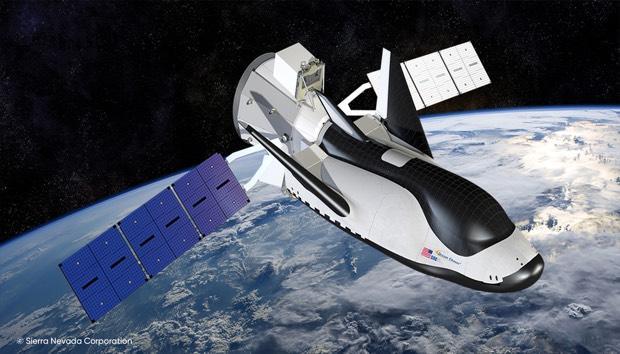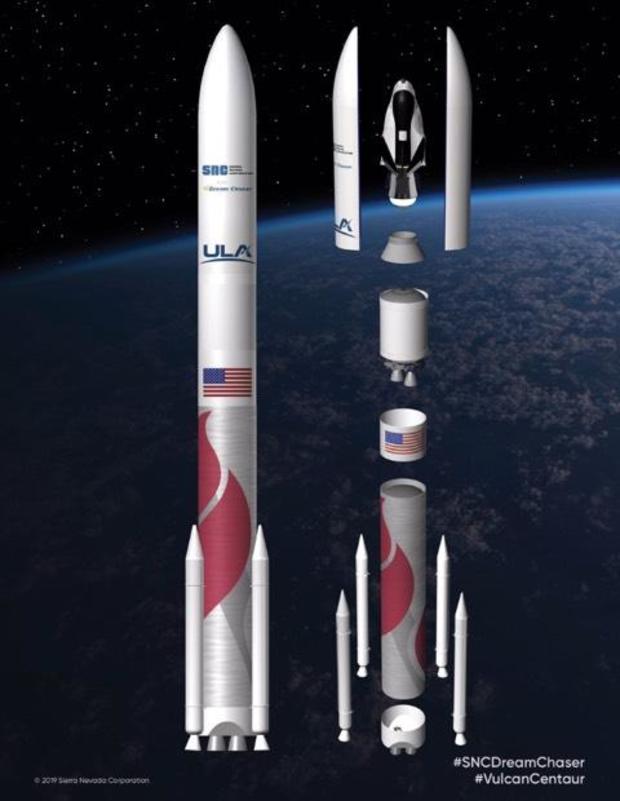Sierra Nevada Corp. will launch its winged Dream Chaser spaceplane atop United Launch Alliance's new Vulcan rocket for at least six NASA-contracted unpiloted cargo flights to the International Space Station (ISS) starting in 2021, company officials announced Wednesday.
Sierra Nevada engineers and the company's owners, Fatih and Eren Ozmen, considered boosters built in Japan, Europe and by SpaceX and Blue Origin. But they ultimately selected United Launch Alliance, they said, based on a competitive - but undisclosed - cost, the Vulcan's capabilities, ULA's unblemished launch record and a long-standing working relationship.
While the six space station resupply missions are baselined to fly on the Vulcan, with ULA's Atlas 5 available as a backup, CEO Fatih Ozmen said the company is holding open the option of launching Dream Chasers commercially on other rockets if demand develops.

"Dream Chaser's really challenging the status quo," he said. "It is the only privately owned, commercial spaceplane in the world that exists, that is runway-landing capable and is reusable. This is very significant.
"Fifty years after Apollo days, believe it or not we are still using capsules, high-G entry and splashing (down) in the ocean for our cargo and crew both. Dream Chaser makes a very unique (package), coupled with the reliability and reusability and cost effectiveness of the Vulcan rocket."
Resembling a small space shuttle, the Dream Chaser originally was designed as a piloted spacecraft that could carry astronauts to and from the ISS.
NASA ultimately selected Boeing and SpaceX to build agency-financed commercial crew ships, but later awarded a contract to SNC for at least six flights of an unpiloted version of the Dream Chaser to carry 12,000 pounds of pressurized and unpressurized cargo to the station.
SpaceX's Dragon supply ship and Northrop Grumman's Cygnus already were under contract to NASA and both companies will continue cargo flights under a second contract along with Sierra Nevada.
SpaceX's Dragon is the only vehicle currently flying that is reusable and can bring significant cargo back to Earth from the station. Dream Chaser also is reusable but unlike the Dragon, which splashes down in the ocean after a mission, the spaceplane is designed to autonomously glide back to a runway landing carrying up to 7,000 pounds of cargo.
It also is designed to fly atop a variety of rockets.

"This is a very competitive launch market now days, and to be selected by SNC to fly this block of missions on our Vulcan launch vehicle is just a tremendous honor, and we're very grateful," said Tory Bruno, ULA CEO. "But really, more important than any of that, to us, is that you have trusted us with your baby, this amazing Dream Chaser vehicle. We will not let you down."
ULA, a partnership between Boeing and Lockheed Martin, is building the Vulcan to replace the company's Delta 4 and Atlas 5 rockets. Both have been extensively used to launch high-priority military, NASA and other government payloads, but the Delta family is more expensive than other launchers and the Atlas has come under fire because of its use of Russian-built RD-180 first stage engines.
The all-American Vulcan will use first stage engines provided by Blue Origin, a company owned by Amazon-founder Jeff Bezos. Aerojet Rocketdyne will provide the Vulcan's Centaur second stage engines and Northrop Grumman will supply strap-on solid-fuel boosters as required depending on payload requirements.
Unlike the first stages used by SpaceX's Falcon 9 rockets and the New Glenn launchers designed by Blue Origin, ULA does not plan to recover the Vulcan's first stage. Instead, the company is developing systems to recover the first stage engines.
"The concept we are pursuing for reusability fits in the category of component reuse," Bruno said. "There's glide-back reuse, like the space shuttle, like this amazing vehicle, there's propulsive fly-back reuse like you see on that other guy's rocket and then there's the third kind, which is to separate the most expensive and valuable parts of the rocket and return them.
"We will separate our engines and recover those. ... That has one of the unique attributes of not having a performance impact. When you propulsively fly back, you save propellant in order to fly home with. We're still able to burn to depletion on our first stage and it would not impact our performance in any significant way."
Bruno said 90% of the Vulcan's major systems, including flight software, the nose fairing, Centaur engines, propellant tanks and strap-on boosters, will have flown on the Atlas 5 before the Vulcan's maiden flight.
"To be able to make Vulcan's' commercial debut with this block of missions underneath the Dream Chaser is just truly exciting," he said. "We commit to you that we are going to bring all of our experience, all of our skill and our discipline in launching this vehicle in taking your dream to space."



Ingen kommentarer:
Legg inn en kommentar
Merk: Bare medlemmer av denne bloggen kan legge inn en kommentar.